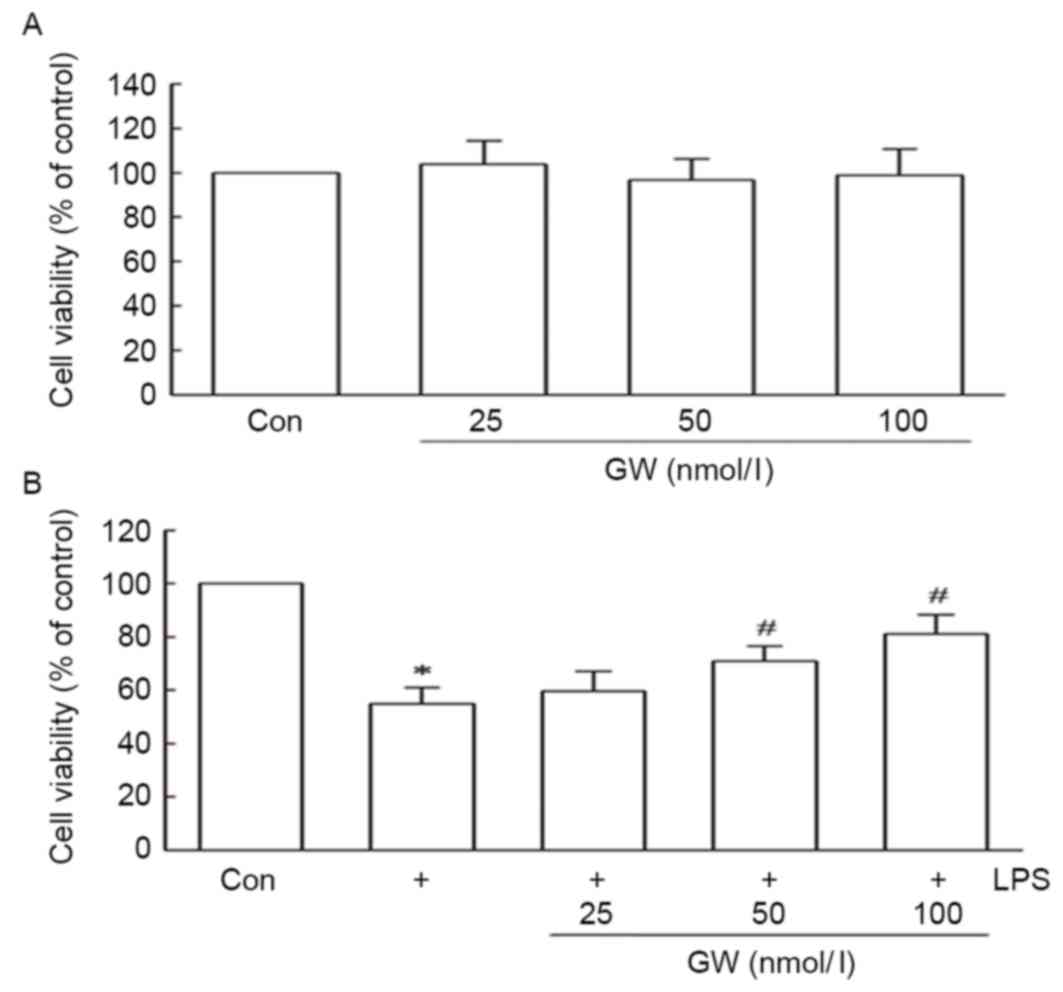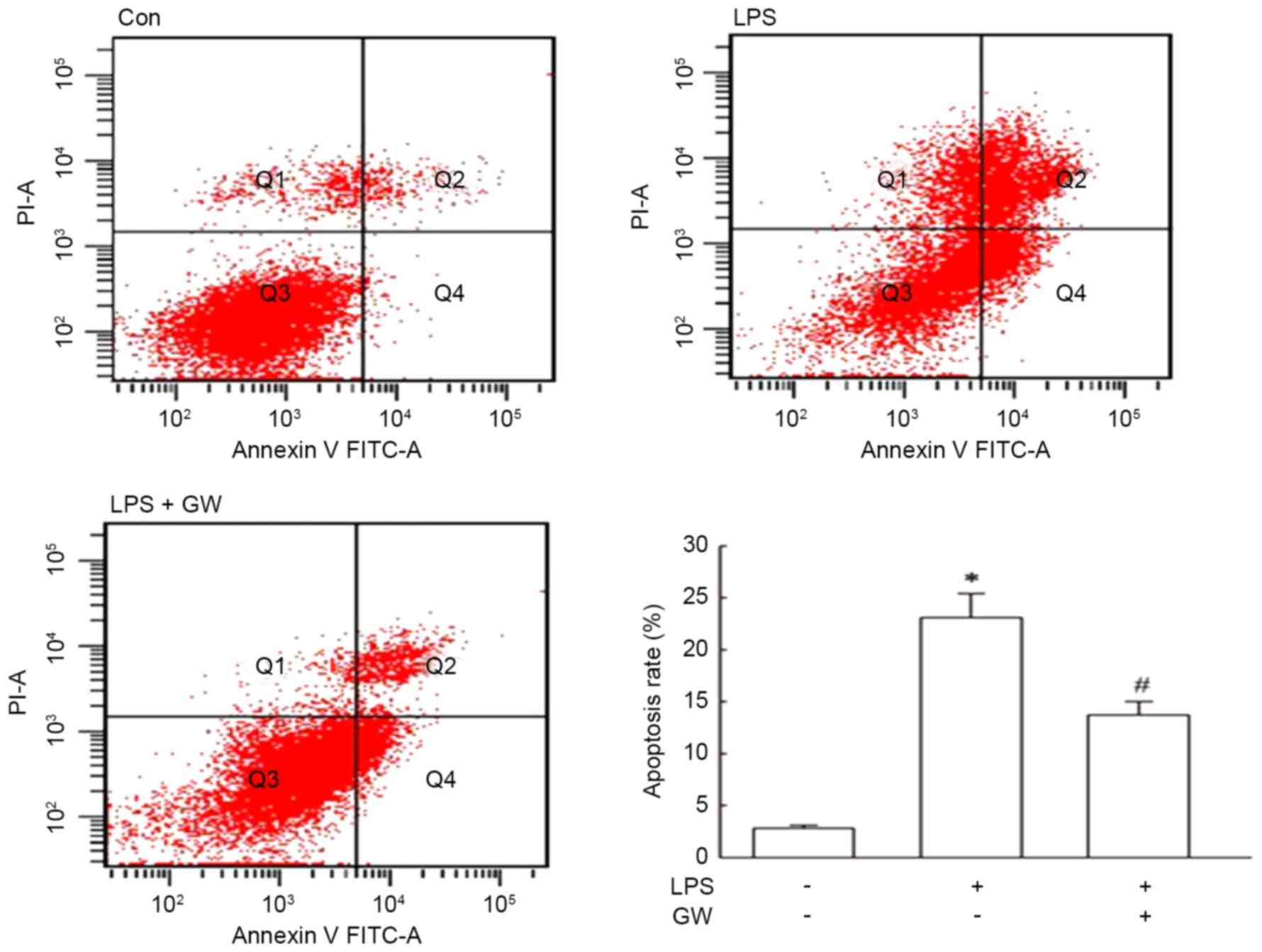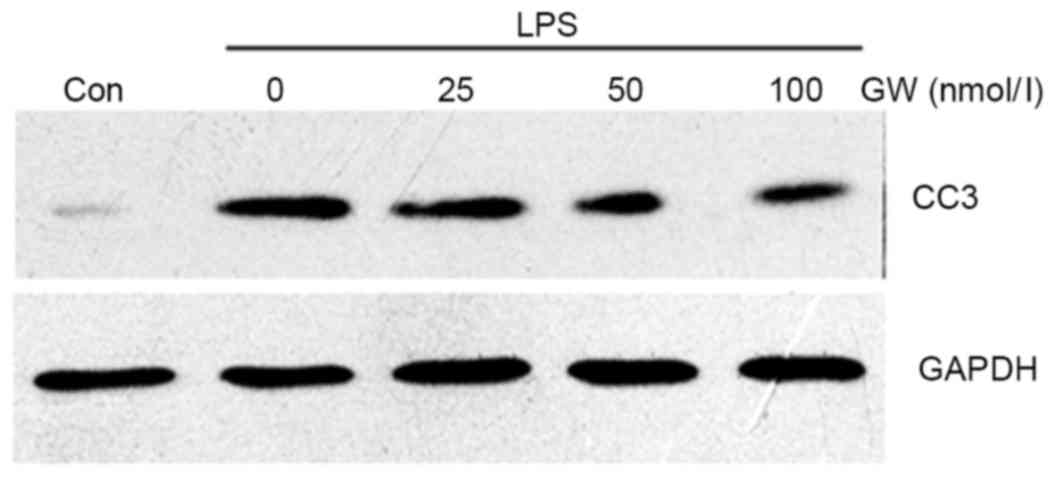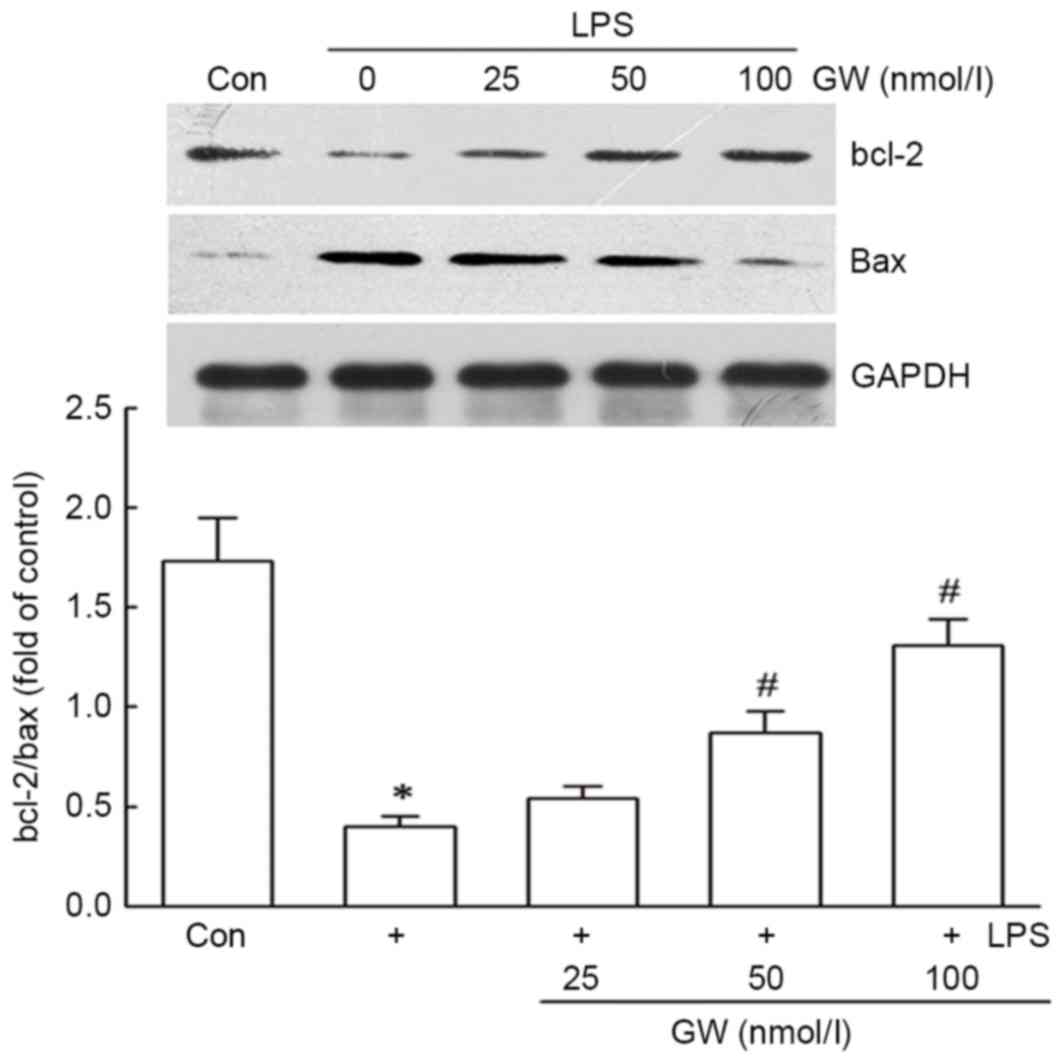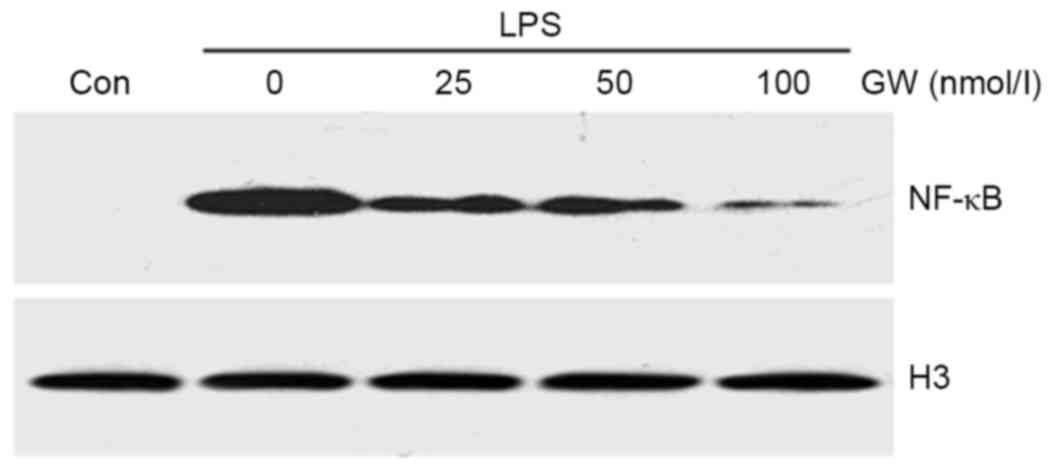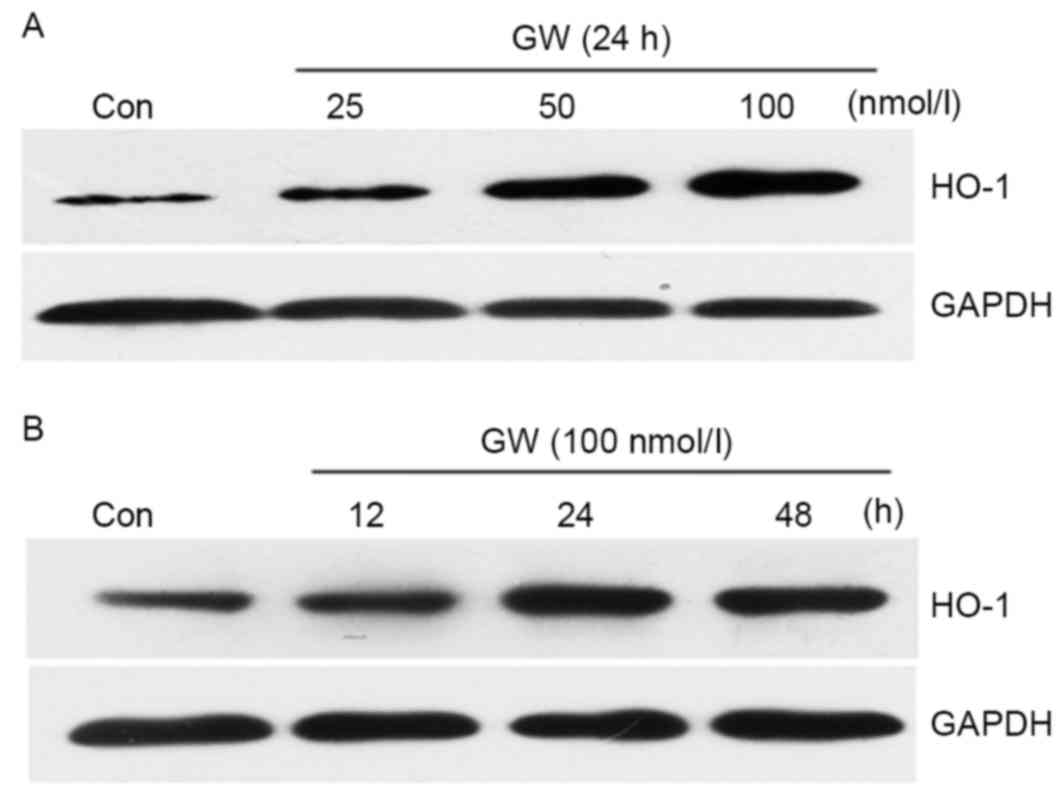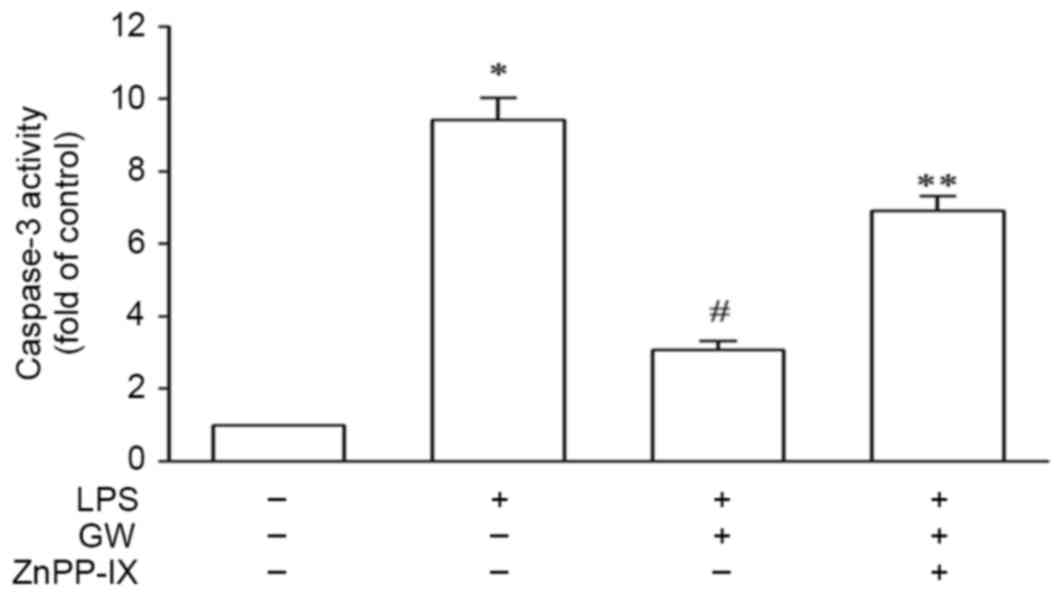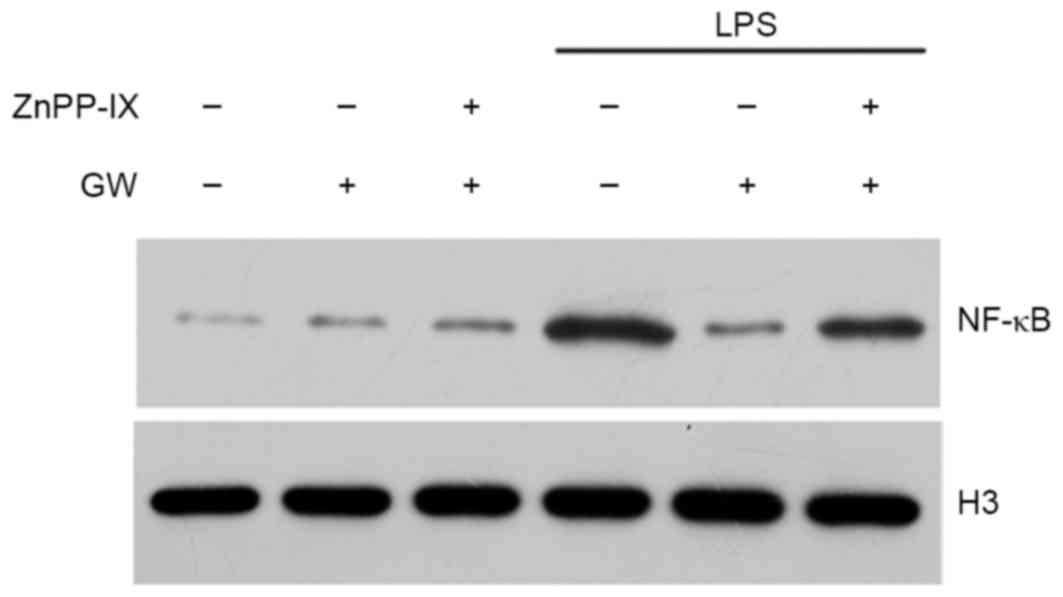PPARδ activation protects H9c2 cardiomyoblasts from LPS‑induced apoptosis through the heme oxygenase‑1‑mediated suppression of NF‑κB activation
- Authors:
- Published online on: April 19, 2017 https://doi.org/10.3892/mmr.2017.6483
- Pages: 3775-3780
Abstract
Introduction
Sepsis remains a significant health problem among pediatric patients (1). Worldwide, it affects a large pediatric population and is the most common cause of mortality in infants and children (2).· Accumulating evidence has indicated that myocardial dysfunction is a common complication in adults and children with severe sepsis (3). However, the cellular mechanisms underlying sepsis-associated myocardial dysfunction are not entirely clear. There is increasing evidence that apoptosis of cardiomyocytes serves an important role in the pathogenesis of sepsis-induced myocardial dysfunction (4). Therefore, therapeutic strategies aimed at preventing the sepsis-induced apoptosis of cardiomyocytes may be a promising option for the treatment of sepsis-associated myocardial dysfunction.
Peroxisome proliferator-activated receptors (PPARs) are ligand-activated nuclear transcriptional activators belonging to the superfamily of nuclear receptors. A total of three PPAR subtypes (α, β/δ and γ) have been identified (5). Although the function of the ubiquitously-expressed PPARδ subtype has received relatively little attention in comparison with the other two subtypes, it has been reported to exhibit a potent role in the regulation of cellular metabolism (6), inflammation (7), apoptosis (8) and angiogenesis (9). Previous experimental evidence has indicated that PPARδ activation protects H9c2 cells from oxidative stress-induced apoptosis (10). However, the possible anti-apoptotic effect of PPARδ activation in lipopolysaccharide (LPS)-stimulated H9c2 cells has not been tested. Furthermore, the precise mechanism underlying this response remains unclear.
Molecular and pharmacological strategies that prevent nuclear factor-κB (NF-κB) activation have been demonstrated to provide considerable myocardial protection in models of endotoxin challenge, thus confirming the vital role of this transcription factor in mediating sepsis-associated myocardial dysfunction (11). Heme oxygenase-1 (HO-1), which is the rate-limiting enzyme responsible for the degradation of heme into free ferrous iron, CO and bilirubin, exerts cytoprotective effects in various diseases (12). It is reported that HO-1 induction serves an important role in the cytoprotective actions of PPARδ in vascular endothelia (13). Recent experimental evidence indicates that heme oxygenase-1 overexpression protects human cardiac endothelial cells from IL-18-induced apoptosis by inhibiting NF-κB activation (14). Therefore, the present study was designed to investigate the effect of the PPARδ-selective agonist GW501516 (GW) on LPS-induced apoptosis in the rat cardiomyoblast cell line H9c2, and to analyze the role of NF-κB and HO-1 in this effect.
Materials and methods
Materials
GW was obtained from Santa Cruz Biotechnology, Inc. (Dallas, TX, USA). Zinc protoporphyrin-IX (Znpp-IX, an HO-1 inhibitor), dimethyl sulfoxide (DMSO), trypsin and MTT were from Sigma-Aldrich (Merck KGaA, Darmstadt, Germany). All culture reagents were from Invitrogen (Thermo Fisher Scientific, Inc., Waltham, MA, USA). LPS, phenylmethanesulfonyl fluoride (PMSF), radioimmunoprecipitation assay (RIPA) buffer, the enhanced bicinchoninic acid (BCA) protein assay kit, all SDS-PAGE reagents, the nuclear and cytoplasmic protein extraction kit, the enhanced chemiluminescence (ECL) substrate reagent kit and the caspase-3 activity kit were obtained from Beyotime Institute of Biotechnology (Jiangsu, China). The Annexin V-fluorescein isothiocyanate (FITC)/propidium iodide (PI) detection kit was from KeyGen Biology (Nanjing, China). Rabbit polyclonal antibodies specific for cleaved caspase-3 (CC3; cat. no. 9661), apoptosis regulator Bcl-2 (bcl-2; cat. no. 2876), apoptosis regulator BAX (bax; cat. no. 2772), NF-κB p65 (cat. no. 3034) and anti-GAPDH (cat. no. 2118; 1:1,000) were from Cell Signaling Technology, Inc. (Danvers, MA, USA). Rabbit polyclonal antibodies specific for HO-1 (cat. no. SPA-896) and histone 3 (H3; cat. no. ab1791) were obtained from Stressgen Bioreagents Corporation (Victoria, BC, Canada) and Abcam (Cambridge, UK), respectively.
Cell culture and treatment protocol
H9c2 cardiomyoblasts (CRL-1446; American Type Culture Collection, Manassas, VA, USA) were maintained in Dulbecco's modified Eagle's medium (DMEM) supplemented with 10% heat-inactivated fetal bovine serum (FBS), 100 U/ml penicillin and 100 µg/ml streptomycin in a humidified atmosphere of 5% CO2 and 95% air at 37°C. Cells were passaged regularly and subcultured to 90% confluence prior to experimental procedures.
GW dissolved in DMSO was diluted with low-serum medium (1% FBS/DMEM) to the final concentrations (25, 50 and 100 nmol/l) before use. The final concentration of DMSO in the incubation mixture was not more than 0.1% (v/v). Prior to experimental intervention, confluent cultured cells were serum-starved for 24 h in low-serum medium. Cells were pretreated with different doses of GW for 24 hat 37°C, and then incubated with 1 µg/ml of LPS for 24 h. For the inhibitor experiment, cells were pretreated with 100 nM of GW for 24 h at 37°C in the absence or presence of 10 µmol/l of ZnPP-IX, which was added 1 h before GW, and then the cells were incubated for 24 h with 1 µg/ml LPS.
Cell viability assay
Cell viability was assessed by MTT assay. Following incubation with the test reagents, 5 mg/ml MTT was added to the culture media and the cells were incubated for an additional 4 h. Subsequent to this incubation, the resulting formazan was solubilized by adding DMSO, and the optical density of the solubilized cell extract was measured at 490 nm using a microplate reader.
Evaluation of cell apoptosis by Annexin V-FITC/PI staining
Apoptosis was detected using an Annexin V-FITC/PI detection kit according to the manufacturer's protocol. The cells were digested with 0.25% trypsin, washed with ice-cold PBS and resuspended in binding buffer (5×105 cells/ml). The cells were centrifuged at 1,000 × g for 5 min at 4°C. Subsequent to the supernatant being discarded, 500 µl binding buffer, 5 µl Annexin V-FITC and 5 µl PI were added to the cell suspension. Following gentle mixing, the suspensions were incubated for 15 min at room temperature without light. The cells were analyzed by flow cytometry (BD LSRII; BD Biosciences, Franklin Lakes, NJ, USA). Data analysis was performed using CellQuest version 3.3 (BD Biosciences).
Caspase-3 activity assay
Caspase-3 activity was determined using a caspase-3 activity kit, which detects the production of the chromophore p-nitroanilide following its cleavage from the peptide substrate DEVD-p-nitroanilide. According to the manufacturer's protocol, following washing with cold PBS, cells were lysed with lysis buffer (100 µl/2×106 cells) for 15 min on ice. The mixture, composed of 10 µl cell lysate, 80 µl reaction buffer and 10 µl 2 mmol/l caspase-3 substrate, was incubated in 96-well plates at 37°C for 4 h, and caspase-3 activity was quantified in the samples using a microplate reader at an absorbance of 405 nm.
Western blot analysis
Cells from each group were washed twice with ice-cold PBS and lysed in RIPA buffer (10 mmol/l Tris, pH 7.4; 150 mmol/l NaCl; 1 mmol/l EDTA; 0.1% SDS; 1% Triton X-100; and 1% sodium deoxycholate) with protease inhibitors (1 mmol/l PMSF, 1 µg/ml aprotinin, 1 µg/ml pepstatin, and 1 µg/ml leupeptin) at 4°C. The lysate was centrifuged at 12,000 × g at 4°C for 20 min to remove the insoluble material. Supernatants were collected. The protein concentration was determined using the BCA assay. Equal quantities of protein (30 µg) were separated by 10% SDS-PAGE, and subsequently transferred onto a polyvinylidene difluoride (PVDF) membrane. The membranes were blocked in TBS with Tween-20 (TBST) with 5% (w/v) skimmed milk at room temperature for 2 h, followed by overnight incubation at 4°C with primary antibodies diluted in 0.1% TBST. Following washing in TBST, the membranes were incubated at room temperature for 1 h with goat anti-rabbit horseradish peroxidase-conjugated secondary antibody (cat. no. 7074; 1:3,000; Cell Signaling Technology, Inc.) diluted in 0.1% TBST. Following washing once more in TBST, the immunoreactive bands were visualized by using an ECL kit and exposed to X-ray film. The band intensity was quantified using Quantity One software (Bio-Rad Laboratories Inc. Hercules, CA, USA).
Nuclear protein extraction
The extraction and isolation of nuclear proteins was performed using the nuclear and cytoplasmic protein extraction kit according to the manufacturer's protocol. Cells were detached with cold PBS and centrifuged at 1,000 × g for 5 min at 4°C, and the pellet was dissolved with cytoplasmic protein extraction agent A supplemented with PMSF. Subsequent to mixing by vortex for 5 sec, the tubes were incubated for 10–15 min on ice to promote lysis. Cytoplasmic protein extraction agent B was added and mixing by vortex was performed for 5 sec, followed by incubation on ice for 60 sec. The samples were centrifuged for 5 min at 14,000 × g at 4°C and the supernatant, consisting of the cytosolic fraction, was immediately frozen for further analysis. The pellet was re-suspended in nuclear protein extraction agent supplemented with PMSF. Subsequently, the tubes were mixed by vortex 15–20 times over the course of 30 min and centrifuged for 10 min at 14,000 × g at 4°C to obtain supernatants containing the nuclear extracts. Protein concentration was measured using the BCA protein assay kit. Levels of NF-κB p65 in the nuclear protein extract were determined by western blot analysis as described above.
Statistical analysis
All data represent the mean of samples from three separately-performed experiments. Results are expressed as mean ± standard deviation. One-way analysis of variance and Student-Newman-Keuls tests were used for statistical evaluation with SPSS 14.0 software (SPSS, Inc., Chicago, IL, USA). P<0.05 was considered to indicate a statistically significant difference.
Results
GW attenuates LPS-induced cytotoxicity
Using the MTT assay, a possible cytoprotective effect of GW against LPS-induced cell death was detected. To evaluate whether GW was cytotoxic to H9c2 cells, the cells were first treated with concentrations of GW ranging between 25 and 100 nmol/l for 24 h. A reduction in cell viability was not observed (Fig. 1A). Subsequent analyses tested whether GW was able to protect against LPS-induced cytotoxicity. When cells were pretreated for 24 h with growing concentrations of GW (25–100 nmol/l), prior to treatment with 1 µg/ml LPS for 24 h, significant increases in cell viability were observed compared with treatment with LPS alone. As exhibited in Fig. 1B, pretreatment with 50 and 100 nmol/l GW significantly increased cell viability to 70.89±5.61 and 81.16±7.12 % of the control, respectively, compared with treatment with LPS alone. These results indicate that GW may have a protective role against LPS-induced cell cytotoxicity.
GW inhibits LPS-induced cell apoptosis
Apoptosis was quantitated by flow cytometry using Annexin V-FITC/PI staining. As presented in Fig. 2, LPS led to a significant increase in the apoptotic rate of H9c2 cells compared with the control group, and the apoptotic rate was decreased markedly by pretreatment with GW compared with the LPS alone group. Subsequent western blot analysis demonstrated that CC3 protein expression was markedly increased in LPS-stimulated cells compared with the control group, while GW pretreatment decreased CC3 protein expression in a dose-dependent manner compared with the LPS group (Fig. 3). Western blot analysis also indicated that GW notably inhibited the decrease of the bcl-2/bax ratio induced by LPS in a dose-dependent manner (Fig. 4).
GW inhibits LPS-induced NF-κB nuclear translocation
To investigate the molecular mechanisms by which GW protects H9c2 cells from LPS-induced apoptosis, the nuclear NF-κB protein expression level was examined to determine whether the regulation of NF-κB is responsible for the anti-apoptotic effect of GW. As displayed in Fig. 5, when cells were pretreated for 24 h with increasing concentrations of GW prior to incubation with LPS, NF-κB protein expression was decreased in a dose-dependent manner compared with the LPS group. These results suggest that GW prevents LPS-induced apoptosis, possibly through inhibition of NF-κB activation.
GW induces HO-1 protein expression
The cells were treated with increasing concentrations of GW (25–100 nmol/l). Treatment with GW for 24 h increased HO-1 expression in a dose-dependent manner (Fig. 6A). HO-1 expression was subsequently determined by treating the cells with 100 nmol/l GW for 12, 24 and 48 h. As presented in Fig. 6B, a maximum increase of HO-1 protein expression was observed following treatment for 24 h.
HO-1 mediates the protective effect of GW against LPS-induced cell apoptosis
In order to validate the protective role of HO-1, H9c2 cells exposed to LPS were pretreated with 100 nmol/l GW for 24 h in the absence or the presence of 10 µM ZnPP-IX. As exhibited in Fig. 7, the caspase-3 activity was increased by 9.42±0.61-fold that of the control in the LPS group, whereas it was reduced to 3.07±0.24-fold that of the control following pretreatment with GW. Co-incubation with ZnPP-IX, which partly negated the effect of GW, increased the caspase-3 activity to 6.91±0.40-fold that of the control. These results suggest that the protective effect of GW on LPS-induced cell apoptosis is HO-1-dependent.
HO-1 mediates the inhibitory effect of GW on NF-κB activation
To determine whether the upregulation of HO-1 by GW is important to the survival of H9c2 cells, due to the modulation of NF-κB, the effects of ZnPP-IX on the expression of NF-κB were tested. H9c2 cells exposed to LPS were pretreated with 100 nmol/l GW for 24 h in the absence or the presence of 10 µM ZnPP-IX. As presented in Fig. 8, ZnPP-IX co-incubation reversed the inhibitory effect of GW on LPS-induced NF-κB activation, suggesting that HO-1 may mediate the inhibitory effect of GW on NF-κB activation in LPS-stimulated H9c2 cells.
Discussion
The present study investigated the anti-apoptotic effect elicited by the selective PPARδ agonist GW in LPS-stimulated H9c2 cardiomyoblasts. The possible mechanism underlying this anti-apoptotic effect was also investigated. It was demonstrated that the activation of NF-κB, induced by LPS, was inhibited significantly by pretreatment with GW. GW also induced HO-1 protein expression in a dose-dependent manner. In addition, it was revealed that HO-1 mediated the inhibitory effect of GW on NF-κB activation in LPS-stimulated H9c2 cells.
The protective effect of GW against LPS-induced cell toxicity was investigated by MTT assay. The results demonstrated that GW protected H9c2 cells from LPS-induced cytotoxicity in a dose-dependent manner. It is known that LPS is a major feature of Gram-negative septic shock, and it has been tested as a stress model for inducing apoptosis in vitro (15). Previously, the activation of PPARδ was demonstrated to be implicated in the suppression of apoptosis in human umbilical vein endothelial cells (16). Therefore, the present study examined whether GW has a protective effect against LPS-induced apoptosis in H9c2 cells.
Apoptosis is typically associated with the regulation of caspase-3 (17) and the family of bcl-2 proteins which include pro-apoptotic protein bax and anti-apoptotic protein bcl-2 (18). The present study provided evidence that pretreatment with GW significantly inhibited the LPS-induced increase in the rate of apoptosis as measured by Annexin V-FITC/PI staining. It was also observed that GW may significantly decrease the expression of CC3, and caspase-3 activity, which are accompanied by a marked increase in the bcl-2/bax ratio. These results demonstrated that the activation of PPARδ may protect H9c2 cells from LPS-induced apoptosis.
LPS is a potent pro-inflammatory cytokine stimulator in cardiomyocytes. A large body of evidence suggests that NF-κB activation, mediated by pro-inflammatory cytokines such as TNF-α or IL-1, serves an important role in the LPS-induced apoptosis of cardiomyocytes (19). A previous report indicated that PPARδ regulated inflammation via NF-κB signaling in sepsis (20). However, whether activation of PPARδ may inhibit apoptosis in LPS-stimulated H9c2 cells via NF-κB signaling is still unknown.
NF-κB is a nuclear transcription factor that regulates expression of a number of genes that are critical for the regulation of tumorigenesis, inflammation and apoptosis. NF-κB is activated by a variety of stimuli that include ischemia, cytokines, hypoxia, free radicals and LPS. In the inactive state, NF-κB is retained in the cytosol through complexation with inhibitor of NF-κB (IκB) proteins. Upon LPS-induced phosphorylation, IκBα is degraded, and NF-κB is released from the cytosolic complex with IκB proteins and translocates to the nucleus, where it promotes the transcription of both pro- and anti-apoptotic proteins (21). The association between cardiac NF-κB activity and apoptosis remains unclear; in certain cellular systems, it has been proven to be detrimental, and in others, protective (22). It has been suggested that the inhibition of NF-κB activation in H9c2 cells may be useful in the prevention of apoptosis induced by LPS (15). In the present study, it was demonstrated that pretreatment with GW inhibited the activation of NF-κB induced by LPS in a dose-dependent manner. These results suggest that GW prevents LPS-induced apoptosis through inhibition of NF-κB activation.
Pharmacological and genetic induction of HO-1 has been demonstrated to exert an anti-apoptotic effect in various cardiovascular diseases (23,24). A previous study demonstrated that HO-1 was upregulated in endothelial cells and vascular smooth muscle cells by GW in vitro (25), and to the best of our knowledge the present study demonstrates for the first time that GW induces HO-1 protein expression in a dose-dependent manner in H9c2 cells. In addition, pretreatment with GW significantly inhibited the LPS-induced activation of caspase-3. This effect was demonstrated to be partly attributed to the induction of HO-1, as the inhibitor of HO-1 (ZnPPIX) markedly reversed the protective effect afforded by GW. These results suggest that the induction of HO-1 may serve a marked role in mediating the anti-apoptotic effect of GW in LPS-stimulated H9c2 cells. Additionally, it was identified in this study that ZnPP-IX co-incubation reversed the inhibitory effect of GW on LPS-induced NF-κB nuclear translocation, which suggests that HO-1 may mediate the inhibitory effect of GW on NF-κB activation in LPS-stimulated H9c2 cells. Therefore, it was concluded that PPARδ activation protects H9c2 cells from LPS-induced apoptosis probably through the HO-1 mediated suppression of NF-κB activation. These results are in agreement with previous reports demonstrating that HO-1 activation attenuates the apoptosis of cardiomyocytes by inhibiting NF-κB activity (24).
A previous study demonstrated that CO, a product of heme metabolism by HO-1, exhibited a potent anti-apoptotic effect in LPS-stimulated endothelial cells (26); however, whether CO is involved in the cytoprotection afforded by GW remains unknown. Therefore, experiments aimed at broadening understanding of the more detailed mechanisms will be the subject of future studies.
In conclusion, the present study demonstrates that GW protects H9c2 cardiomyoblasts against LPS-induced apoptosis. The protective effect of GW was demonstrated to be associated with the HO-1 mediated suppression of NF-κB activation. The results suggest that PPARδ is a promising therapeutic target for the treatment of sepsis-associated cardiac dysfunction.
References
|
Czaja AS, Zimmerman JJ and Nathens AB: Readmission and late mortality after pediatric severe sepsis. Pediatrics. 123:849–857. 2009. View Article : Google Scholar : PubMed/NCBI | |
|
Watson RS, Carcillo JA, Linde-Zwirble WT, Clermont G, Lidicker J and Angus DC: The epidemiology of severe sepsis in children in the United States. Am J Respir Crit Care Med. 167:695–701. 2003. View Article : Google Scholar : PubMed/NCBI | |
|
Maeder M, Fehr T, Rickli H and Ammann P: Sepsis-associated myocardial dysfunction: Diagnostic and prognostic impact of cardiac troponins and natriuretic peptides. Chest. 129:1349–1366. 2006. View Article : Google Scholar : PubMed/NCBI | |
|
Ayala A, Perl M, Venet F, Lomas-Neira J, Swan R and Chung CS: Apoptosis in sepsis: Mechanisms, clinical impact and potential therapeutic targets. Curr Pharm Des. 14:1853–1859. 2008. View Article : Google Scholar : PubMed/NCBI | |
|
Ehrenborg E and Krook A: Regulation of skeletal muscle physiology and metabolism by peroxisome proliferator-activated receptor delta. Pharmacol Rev. 61:373–393. 2009. View Article : Google Scholar : PubMed/NCBI | |
|
Barish GD, Narkar VA and Evans RM: PPAR delta: A dagger in the heart of the metabolic syndrome. J Clin Invest. 116:590–597. 2006. View Article : Google Scholar : PubMed/NCBI | |
|
Li AC, Binder CJ, Gutierrez A, Brown KK, Plotkin CR, Pattison JW, Valledor AF, Davis RA, Willson TM, Witztum JL, et al: Differential inhibition of macrophage foam-cell formation and atherosclerosis in mice by PPARalpha, beta/delta, and gamma. J Clin Invest. 114:1564–1576. 2004. View Article : Google Scholar : PubMed/NCBI | |
|
Liou JY, Lee S, Ghelani D, Matijevic-Aleksic N and Wu KK: Protection of endothelial survival by peroxisome proliferator-activated receptor-delta mediated 14-3-3 upregulation. Arterioscler Thromb Vasc Biol. 26:1481–1487. 2006. View Article : Google Scholar : PubMed/NCBI | |
|
Piqueras L, Reynolds AR, Hodivala-Dilke KM, Alfranca A, Redondo JM, Hatae T, Tanabe T, Warner TD and Bishop-Bailey D: Activation of PPARbeta/delta induces endothelial cell proliferation and angiogenesis. Arterioscler Thromb Vasc Biol. 27:63–69. 2007. View Article : Google Scholar : PubMed/NCBI | |
|
Pesant M, Sueur S, Dutartre P, Tallandier M, Grimaldi PA, Rochette L and Connat JL: Peroxisome proliferator-activated receptor delta (PPARdelta) activation protects H9c2 cardiomyoblasts from oxidative stress-induced apoptosis. Cardiovasc Res. 69:440–449. 2006. View Article : Google Scholar : PubMed/NCBI | |
|
Carlson D, Maass DL, White DJ, Tan J and Horton JW: Antioxidant vitamin therapy alters sepsis-related apoptotic myocardial activity and inflammatory responses. Am J Physiol Heart Circ Physiol. 291:H2779–H2789. 2006. View Article : Google Scholar : PubMed/NCBI | |
|
Otterbein LE and Choi AM: Heme oxygenase: Colors of defense against cellular stress. Am J Physiol Lung Cell Mol Physiol. 279:L1029–L1037. 2000.PubMed/NCBI | |
|
Ali F, Ali NS, Bauer A, Boyle JJ, Hamdulay SS, Haskard DO, Randi AM and Mason JC: PPARdelta and PGC1alpha act cooperatively to induce haem oxygenase-1 and enhance vascular endothelial cell resistance to stress. Cardiovasc Res. 85:701–710. 2010. View Article : Google Scholar : PubMed/NCBI | |
|
Zabalgoitia M, Colston JT, Reddy SV, Holt JW, Regan RF, Stec DE, Rimoldi JM, Valente AJ and Chandrasekar B: Carbon monoxide donors or heme oxygenase-1 (HO-1) overexpression blocks interleukin-18-mediated NF-kappaB-PTEN-dependent human cardiac endothelial cell death. Free Radic Biol Med. 44:284–298. 2008. View Article : Google Scholar : PubMed/NCBI | |
|
Tien YC, Lin JY, Lai CH, Kuo CH, Lin WY, Tsai CH, Tsai FJ, Cheng YC, Peng WH and Huang CY: Carthamus tinctorius L. Prevents LPS-induced TNFalpha signaling activation and cell apoptosis through JNK1/2-NFkappaB pathway inhibition in H9c2 cardiomyoblast cells. J Ethnopharmacol. 130:505–513. 2010. View Article : Google Scholar : PubMed/NCBI | |
|
Jiang B, Liang P, Zhang B, Song J, Huang X and Xiao X: Role of PPAR-beta in hydrogen peroxide-induced apoptosis in human umbilical vein endothelial cells. Atherosclerosis. 204:353–358. 2009. View Article : Google Scholar : PubMed/NCBI | |
|
Cryns V and Yuan J: Proteases to die for. Genes Dev. 12:1551–1570. 1998. View Article : Google Scholar : PubMed/NCBI | |
|
Oltvai ZN, Milliman CL and Korsmeyer SJ: Bcl-2 heterodimerizes in vivo with a conserved homolog, Bax, that accelerates programmed cell death. Cell. 74:609–619. 1993. View Article : Google Scholar : PubMed/NCBI | |
|
Wang X, Zingarelli B, O'Connor M, Zhang P, Adeyemo A, Kranias EG, Wang Y and Fan GC: Overexpression of Hsp20 prevents endotoxin-induced myocardial dysfunction and apoptosis via inhibition of NF-kappaB activation. J Mol Cell Cardiol. 47:382–390. 2009. View Article : Google Scholar : PubMed/NCBI | |
|
Zingarelli B, Piraino G, Hake PW, O'Connor M, Denenberg A, Fan H and Cook JA: Peroxisome proliferator-activated receptor {delta} regulates inflammation via NF-{kappa}B signaling in polymicrobial sepsis. Am J Pathol. 177:1834–1847. 2010. View Article : Google Scholar : PubMed/NCBI | |
|
Abdulkhalek S, Guo M, Amith SR, Jayanth P and Szewczuk MR: G-protein coupled receptor agonists mediate Neu1 sialidase and matrix metalloproteinase-9 cross-talk to induce transactivation of TOLL-like receptors and cellular signaling. Cell Signal. 24:2035–2042. 2012. View Article : Google Scholar : PubMed/NCBI | |
|
Delhalle S, Blasius R, Dicato M and Diederich M: A beginner's guide to NF-kappaB signaling pathways. Ann N Y Acad Sci. 1030:1–13. 2004. View Article : Google Scholar : PubMed/NCBI | |
|
Wang G, Hamid T, Keith RJ, Zhou G, Partridge CR, Xiang X, Kingery JR, Lewis RK, Li Q, Rokosh DG, et al: Cardioprotective and antiapoptotic effects of heme oxygenase-1 in the failing heart. Circulation. 121:1912–1925. 2010. View Article : Google Scholar : PubMed/NCBI | |
|
Yeh CH, Chen TP, Wang YC, Lin YM and Lin PJ: HO-1 activation can attenuate cardiomyocytic apoptosis via inhibition of NF-kappaB and AP-1 translocation following cardiac global ischemia and reperfusion. J Surg Res. 155:147–156. 2009. View Article : Google Scholar : PubMed/NCBI | |
|
Kim HJ, Ham SA, Paek KS, Hwang JS, Jung SY, Kim MY, Jin H, Kang ES, Woo IS, Kim HJ, et al: Transcriptional up-regulation of antioxidant genes by PPARδ inhibits angiotensin II-induced premature senescence in vascular smooth muscle cells. Biochem Biophys Res Commun. 406:564–569. 2011. View Article : Google Scholar : PubMed/NCBI | |
|
Bernardini C, Zannoni A, Bacci ML and Forni M: Protective effect of carbon monoxide pre-conditioning on LPS-induced endothelial cell stress. Cell Stress Chaperones. 15:219–224. 2010. View Article : Google Scholar : PubMed/NCBI |



